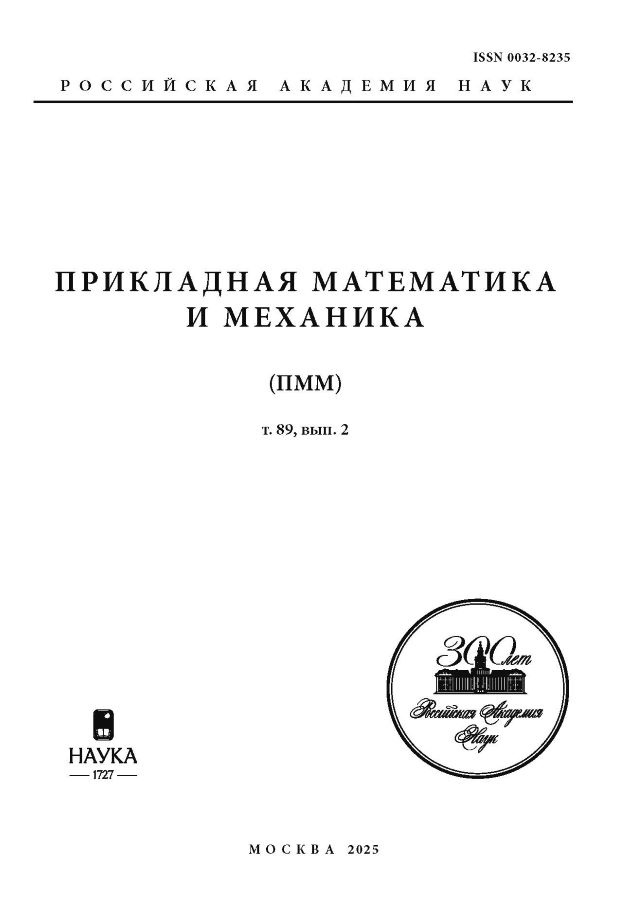Loading analysis of thick-walled shells in Ilyushin stress space during autofrettage
- Autores: Andrianov I.K.1, Feoktistov S.I.1
-
Afiliações:
- Komsomolsk-na-Amure State University
- Edição: Volume 89, Nº 2 (2025)
- Páginas: 295-309
- Seção: Articles
- URL: https://bakhtiniada.ru/0032-8235/article/view/306634
- DOI: https://doi.org/10.31857/S0032823525020087
- EDN: https://elibrary.ru/iloxix
- ID: 306634
Citar
Resumo
The study is devoted to the problem of applying the method of variable elasticity parameters, which uses the provisions of the deformation theory of plasticity, to solving problems of autofreting cylindrical shells loaded with internal pressure. The paper considers two cases of autofreting thick-walled cylindrical shells: with longitudinal stretching and without longitudinal stretching. When determining the stress-strain state, the shell material was considered incompressible and dependencies in the form of a power function and linear power functions were used to describe the deformation diagram of the material. The analysis of the loading process was carried out by studying the loading trajectories of various points of the shell wall in the Ilyushin stress space and the Nadai–Lode parameter for stresses. As studies have shown, in the case of autofreting with longitudinal tension, as well as when loading the shell with internal pressure up to destruction, loading is simple for all functions describing the deformation diagram, which proves the validity of solving such problems by the method of variable elasticity parameters. When autofreting the shell without longitudinal stretching, using a power approximation of the deformation diagram, the loading process up to destruction can be considered simple, which corresponds to Ilyushin’s theorem on simple loading. With the linear-power approximation of the deformation diagram, the process of loading the shell is not simple, but a comparative analysis of the stress state obtained with the power-law and linear-power approximation of the deformation diagram showed a slight difference at all stages of loading. Moreover, these differences decrease with increasing pressure, which allows us to conclude that the method of variable elasticity parameters can be applied to solving problems of autofreting cylindrical shells without longitudinal stretching, as well as loading such shells with internal pressure up to destruction.
Sobre autores
I. Andrianov
Komsomolsk-na-Amure State University
Autor responsável pela correspondência
Email: ivan_andrianov_90@mail.ru
Komsomolsk-na-Amure, Russia
S. Feoktistov
Komsomolsk-na-Amure State University
Email: serg_feo@mail.ru
Komsomolsk-na-Amure, Russia
Bibliografia
- Shufen R., Dixit U.S. A review of theoretical and experimental research on various autofrettage processes // J. Pressure Vessel Technol., 2018, vol. 140, no. 5, pp. 050802.
- Zhu R., Zhu G., Tang F. Analysis on autofrettage of cylinders // Chin. J. Mech. Eng, 2012, no. 25, pp. 615–623. https://doi.org/10.3901/CJME.2012.03.615
- Dixit U.S., Kamal S.M., Shufen R. Autofrettage Processes: Technology and Modelling. Boca Raton: CRC Press, 2019. 276 p.
- Sun L., Sun L., Li G., Wang Y., Mitrouchev P. Research on optimum autofrettage pressure of thick-walled cylinders // in: Lecture Notes in Electrical Engng., 2024, vol. 1154. https://doi.org/10.1007/978-981-97-0665-5_42
- Rajput M., Kamal S.M., Patil R.U. Analysis of thermal autofrettage of disks using von Mises yield criteria // in: Lecture Notes in Mech. Engng. Springer: Singapore, 2024. https://doi.org/10.1007/978-981-97-0418-7_31
- Hu Z., Parker A.P. Residual Stress Analysis of Re-autofrettage of a Swage-Autofrettaged tube by computer modeling incorporating accurate material representation // J. of Mater. Eng.&Perform, 2024, no. 33, pp. 7455–7464. https://doi.org/10.1007/s11665-024-09272-2
- Mohamed E., Ramin S., Ossama R. Development of an efficient design optimization strategy for thick-walled cylinders treated with combinations of autofrettage, shrink-fit and wire-winding processes // Int. J. Engng. Sci.&Technol., 2024, no. 57, pp. 101799. https://doi.org/10.1016/j.jestch.2024.101799
- Kim T., Kim H.Y. Optimal autofrettage process design for enhancing the fatigue life of the ultra-high-pressure hydrogen valve // J. Mech. Sci. Technol., 2024, no. 38, pp. 4847–4859. https://doi.org/10.1007/s12206-024-0820-7
- Jahed H., Dubey R.N. An axisymmetric method of elasticplastic analysis capable of pre-dicting residual stress field // ASME J. of Pressure Vessel Technol., 1997, no. 119 (3), pp. 264–273.
- Smirnov-Alyaev G.A. Theory of Self-Fastening of Cylinders. Moscow: Oborongiz, 1940. 284 p. (in Russian)
- Malinin N.N. Applied Theory of Plasticity and Creep. Moscow: Mashinostroenie, 1975. 399 p. (in Russian)
- Pisarenko G.S., Mozharovsky N.S. Equations and Boundary Value Problems of the Theory of Plasticity and Creep. Kiev: Nauk. Dumka, 1981. 496 p. (in Russian)
- Andrianov I.K., Feoktistov S.I. Inverse problem of elastic-plastic deformation of a free thick-walled cylindrical shell taking into account the nonlinear law of hardening // Probl. of Strength&Plasticity, 2024, no. 86, pp. 259–269. https://doi.org/10.32326/1814-9146-2024-86-3-259-269
- Andrianov I.K., Feoktistov S.I. Bearing capacity of spherical thick-walled shell taking into account compressibility and nonlinear plasticity // Mater. Phys.&Mech., 2022, no. 50(3), pp. 410–419. https://doi.org/10.18149/MPM.5032022_5
- Feoktistov S.I., Andrianov I.K., Htet L. Modeling of the stress-strain state of thick-walled cylindrical shells taking into account the physical nonlinearity of the material // Sci. Notes of Komsomolsk-on-Amur State Tech. Univ., 2022, no. 3 (59), pp. 12–20. (in Russian) https:/doi.org/10.17084/20764359-2022-59-12
- Zubchaninov V.G. Fundamentals of the Theory of Elasticity and Plasticity. Moscow : Vysshaya Shkola, 1990. 367 p. (in Russian)
- Hodge P.G., White G.N. A quantative comparison of flow and deformation theories of plasticity // J. of Appl. Mech., 1950, vol. 17, no. 2, pp. 180–184.
Arquivos suplementares









